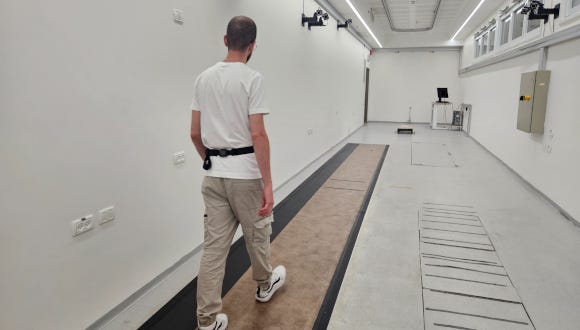How you walk can predict your risk for Alzheimer’s disease
This technology can be integrated into a wearable device attached to the lower back, allowing for continuous step monitoring in everyday life.

A person walking in a state-of-the-art gait lab, with a wearable sensor positioned on his lower back. (CREDIT: Tel Aviv University)
Israeli researchers have found that the way you walk could reveal your risk for Alzheimer's or other neurological disorders.
A study published in Digital Medicine details how a team from Tel Aviv University and Ichilov’s Tel Aviv Sourasky Medical Center has developed a machine learning model to precisely measure step length.
This model can be integrated into developed a machine learning model to accurately measure step length. This technology can be integrated into a wearable device attached to the lower back, allowing for continuous step monitoring in everyday life.
"Step length is a sensitive indicator for various conditions, from cognitive decline to Parkinson’s disease," the researchers explained. "Current devices are bulky and only available in specialized clinics. Our model enables precise measurement in natural settings using a wearable sensor."
Led by Assaf Zadka, Prof. Jeffrey Hausdorff, and Prof. Neta Rabin of Tel Aviv University, the study also included researchers from Belgium, England, Italy, Holland, and the U.S. Prof. Hausdorff emphasized the limitations of existing methods, which only capture brief snapshots of walking behavior. "Daily walking can be influenced by factors like fatigue, mood, and medication. Continuous monitoring captures real-world walking behavior," he said.
Prof. Rabin, a machine learning expert, described how smartphone measurements can detect elevated susceptibility to certain illnesses. The team utilized IMU (inertial measurement unit) systems—sensors found in smartphones and smartwatches—to solve the problem.
Previous studies on IMU-based devices only involved healthy subjects and were not generalizable or comfortable. The goal was to create a device suitable for people with walking issues, enabling day-long data collection in familiar environments.
Related Stories
To develop the algorithm, the researchers used IMU sensor-based gait data and conventional step length data from 472 subjects with various conditions, including Alzheimer's, Parkinson's, mild cognitive impairment, multiple sclerosis, and healthy individuals. This generated a diverse database of 83,569 steps.
The team employed machine learning to train models that translated IMU data into step length estimates. To test the models' robustness, they assessed their ability to analyze new data accurately.
"The XGBoost model proved the most accurate, being 3.5 times more precise than the current advanced biomechanical model," said Zadka. "For a single step, our model's average error was 6 cm, compared to 21 cm for the conventional model. Evaluating an average of 10 steps, the error dropped to less than 5 cm, a clinically significant threshold."
The study's findings suggest the model's reliability and potential for real-world application. "Our model is robust and reliable, suitable for analyzing sensor data from subjects with walking difficulties who weren't part of the original training set," Zadka concluded.
This research marks a significant advancement in non-invasive monitoring of neurological conditions, offering a practical and accurate method to track and potentially predict the progression of diseases like Alzheimer's and Parkinson's.
Note: Materials provided above by The Brighter Side of News. Content may be edited for style and length.
Like these kind of feel good stories? Get The Brighter Side of News' newsletter.
Joshua Shavit
Science & Technology Writer | AI and Robotics Reporter
Joshua Shavit is a Los Angeles-based science and technology writer with a passion for exploring the breakthroughs shaping the future. As a contributor to The Brighter Side of News, he focuses on positive and transformative advancements in AI, technology, physics, engineering, robotics and space science. Joshua is currently working towards a Bachelor of Science in Business Administration at the University of California, Berkeley. He combines his academic background with a talent for storytelling, making complex scientific discoveries engaging and accessible. His work highlights the innovators behind the ideas, bringing readers closer to the people driving progress.



